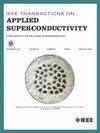A Fast Numerical Approach Toward AC Loss and Critical Current of Large-Scale Stacked Cables
IF 1.8
3区 物理与天体物理
Q3 ENGINEERING, ELECTRICAL & ELECTRONIC
引用次数: 0
Abstract
Evaluating ac loss and critical current of large-scale high-temperature superconducting cables is one of the fundamental studies toward fusion magnet applications. In this article, a new and fast numerical method is proposed for the calculation of ac loss of large-scale stacked cables. The model consists of the大型堆叠电缆交流损耗和临界电流的快速数值计算方法
评估大型高温超导电缆的交流损耗和临界电流是核聚变磁体应用的基础研究之一。本文提出了一种新的快速计算大型堆叠电缆交流损耗的数值方法。该模型由$J$积分公式和快速多极子方法(FMM)组成。与$T$积分公式相比,$J$积分公式具有更好的非线性收敛性。同时,FMM成功地将密集矩阵的存储空间和计算复杂度从$O(N^{2})$降低到$O(N)$。本文通过分析由十股准各向同性股组成的卢瑟福电缆的交流损耗,比较了三种模型的计算性能。考虑的模型有$T$-$A$公式、$J$积分公式和$J$积分公式。结果表明,有FMM的$J$积分公式的计算性能明显优于没有FMM的$T$-$A$公式和$J$积分公式。此外,该模型还可用于卢瑟福电缆临界电流的评估。
本文章由计算机程序翻译,如有差异,请以英文原文为准。
求助全文
约1分钟内获得全文
求助全文
来源期刊

IEEE Transactions on Applied Superconductivity
工程技术-工程:电子与电气
CiteScore
3.50
自引率
33.30%
发文量
650
审稿时长
2.3 months
期刊介绍:
IEEE Transactions on Applied Superconductivity (TAS) contains articles on the applications of superconductivity and other relevant technology. Electronic applications include analog and digital circuits employing thin films and active devices such as Josephson junctions. Large scale applications include magnets for power applications such as motors and generators, for magnetic resonance, for accelerators, and cable applications such as power transmission.
 求助内容:
求助内容: 应助结果提醒方式:
应助结果提醒方式:


